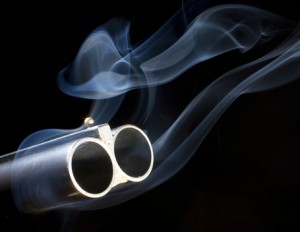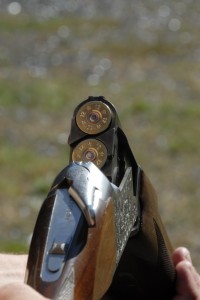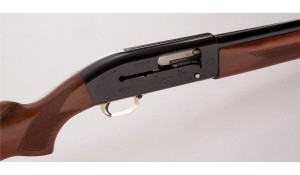A Comprehensive Clay Pigeon Shooting Guide
Types of Shotgun
Side by Side, Semi-Automatic and Over and Under are the 3 main gun designs used by the majority of shooters.
Traditional Game Shooters tend to use side by side shotguns. Their barrels are next to each other.
With over and unders, the barrels are on top of each other.
Over and unders are normally used for clay shooting.
Semi automatic 12 bores are loaded one cartridge after another into the breech, as semi autos only have 1 barrel.
The vast majority of shooters normally use twelve bore shotguns as they are the best combination of weight and performance for most of targets you will see.
Many ladies, juniors and older shooters looking for a lighter gun with less recoil, opt for a twenty bore gun which is smaller and lighter and uses smaller cartridges.
Required Shooting Equipment
Gun Slip
A good gun sleeve will protect your expensive gun from damage while you are carrying it.
Cartridge Carrying Bags
There are many different types of cartridge bag on sale, from belt pouches designed to hold up to fifty cartridges at once to large holdall type bags which allow a shooter to carry a variety of different cartridges that may be needed for different clay targets during a competitive shoot.
Eye Wear
Different tints, clear, orange and yellow lenses will help you to pick out a clay pigeon against different backgrounds and in differing light conditions, while also protecting your eyes from bits of clay.
Ear Protection
Shot Guns make a noise, and while it isn’t dangerously loud enough to damage your hearing instantly, eventually the noise of a shotgun can cause ear damage. Reputable Shooting Venues will insist that all shooters wear ear defenders, which are available in different types, foam plugs, molded plugs, electronic molded ear plugs as well as passive ear muffs and electronic ear muffs.
Shotgun Cartridge Information
There are lots of manufacturers to choose from and most people have a favourite. Your preferred shells will ordinarily be the ones you have shot best with!
There are 2 variations of cartridge available; lead shot velocity and size. Faster cartridges usually cost more. Lead shot for clay pigeon shooting ranges from 6 ½ to 9 in size. 6 ½ has a large lead shot diameter, but less pellets per cartridge.
Larger pellets will fly further so are ideally suited to long distance targets. In a size 9 shell, the shot is much smaller, but there are lots more of them. They don’t have the weight to go as far, but offer a bigger pattern of more pellets at closer range.
The shot velocity of each cartridge comes down to individual preferences. Higher velocity cartridges are more expensive, but favour some shooting styles. To shoot with a lower velocity shot load, all you have to do is to allow more time for the lead to get to the target…. Easy! Shot speed varies from 1350 – 1650 feet/second.
Two Primary Shooting Disciplines
Shooting Skeet
Skeet is the discipline used in the Olympics. Skeet clay shooting consists of two clay traps which face one another and the clays fly through an identical flight path within a small tolerance.
There are twenty five clays in a round, which are shot from each of the seven shooting positions. The most successful shots will often achieve 100 straight without loss.
Sporting Clays
Sporting targets are designed to mimic different game shooting. You’ll see a range of clays and each stand will offer you a different challenge.
Types of Clay Target
‘Standard’ clays are 110mm dia.
A Midi is a smaller standard, 90mm in dia.
A Mini is the same shape as a ‘standard’ target, but only 60mm across. They are small and look far quicker than they often are.
A Battue is a flat target with a stepped outer edge, with a 55mm radius. They are mainly used for looping targets because they turn as they slow down, always providing the shooter with a new challenge!
Rabbits ape real rabbits, so the clays have to be tougher so they don’t break easily when they bounce across the ground.
Principles of Clay Pigeon shooting
Shooting is like catching a ball. You don’t put your hand to where the ball currently is, but where the ball is going to be. In the same way, you shoot to position your shot in the path of the moving clay.
Hitting clay pigeons requires good hand/eye coordination as well as the ability to ‘read’ what a target is doing as it moves.
Shot from your cartridge flies in an oval cigar shape. All you have to do is to place that cigar of lead in the path of the clay.
Your shot is moving at speeds between 1350 and 1650 ft/s, and the clay is moving too.
Many experienced guns still get caught out by clays that are set up to be optical illusions.
Two Simple Shooting Methods
The speed that you move your gun along with pulling the trigger at exactly the right moment are the 2 most important factors that will determine if you hit or miss the clay. The two most popular shooting styles are ‘swing through’ and ‘maintain lead’.
A target needs an amount of lead in front of it where you need to shoot in order to hit the clay. Maintain lead is a measured technique of tracking the clays path, staying in front of it by the exact distance of lead that you estimate the clay needs.
Swing through is a technique that is regularly used by experienced shooters. Instead of measuring the shot, the shooter swings through the clay from behind, squeezing the trigger when their gut instinct tells them it’s right to do so.
Target Types
The seven different types of clays simulate the different varieties of game.
Rabbit
Rabbit clays simulate running rabbits. The clays are 110mm in diameter and are stronger than standards to withstand repeatedly hitting the ground.
Simulated Teal
Hitting rising Teal requires a swing through technique unlike any other. Many shooters prefer to shoot Teal as they drop. Either way, they require lots of practice to hit consistently.
Quartering Clays
By looking at where the target comes from and where it lands you can see how much the target is quartering towards or away from you. Quartering clays often need less lead than a crossing target, so knowing its true flight path is critical.
Driven
Driven targets simulate game being driven towards you. Your gun barrels will hide the target just as you need to shoot, so you have to use a swing through technique to hit them consistently.
Incoming Birds
Incoming targets fly towards you from a variety of angles. Unlike driven targets, they normally fall before reaching the shooter rather than flying on you’re your head.
Going Away Clays
To hit a going away target, you need to address the target quickly before it gets too far away to break.
Looper Clays
Looping targets start off rising, before falling, and often quarter towards or away from you. Hitting a looping target consistently can be tricky and requires patience and practice. Some prefer to hit them rising, while others wait for them to begin to drop before taking a shot.


